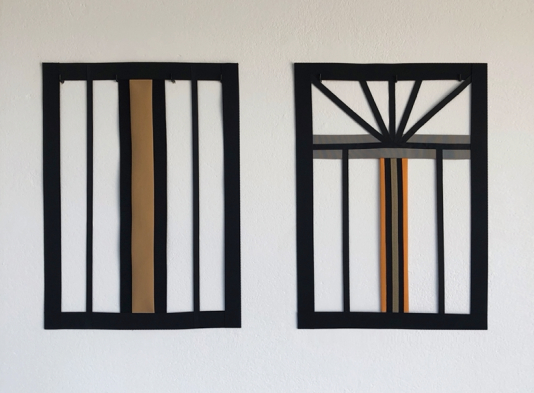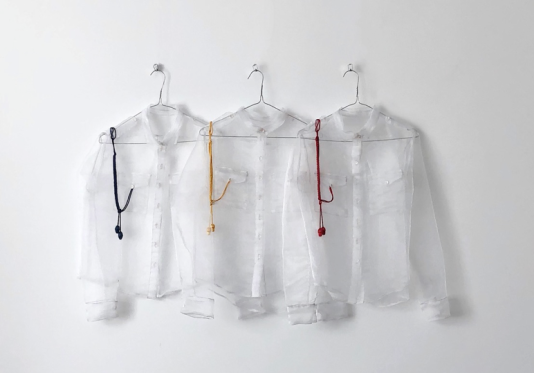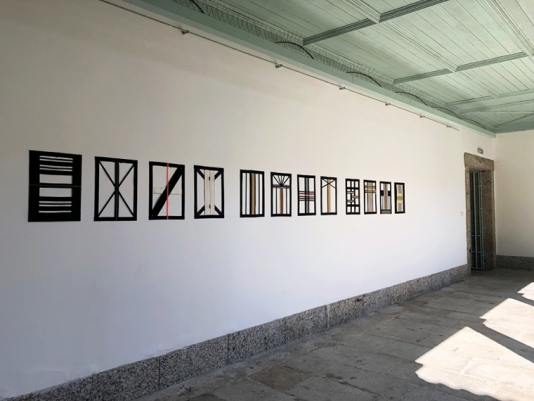Currently lives and works in: Bucharest
Practice: Visual arts
I am using different media such as textile installations and videos or drawings in a quest for the composition of lines and neutral colours evoking order and discipline as repetition. I am working with geometric shapes on the idea of non-hierarchical structures, where folding and unfolding is a sequence of the same horizontal movement. The annulment of the action through linearity and horizontality generates the idea of equality where strength and frailty are balanced.
At the basis of my artistic practice, there is a social and cultural critique of the conventions that have distorted an otherwise infinite realm of possibilities of enacting femininity. Using the same tropes, I made the works Under Ordinate (2019) or Intervention on cotton table placemats (2021), bringing into question the examination of domesticity and the traces that the whole process influenced by social dogmas leaves behind.
My interest in geometry from the perspective of building non-hierarchical geometric structures has been accompanied during the last few years by experiments approaching the building of the relations between objects and space [Square Layers (2022) or Frames 1,2,3,4 (2022)]. The continuous process of fabric transformation, the interaction between the different materials, the space and time dynamics are transposed in the installations stemming from this perspective.
Areas of interest: Literature, social art, architecture, geometry
Why are you a part of MagiC Carpets: I was proposed by the curator Raluca Elena Doroftei through Meta Cultural Foundation for the open call launched between MagiC Carpets – Creative Europe Platform and Ideas Emergentes partners through the curator Claudia Melo and selected in this open call. I was working with the local community and I spent five weeks residency in the city of Guimaraes, Portugal. At the end of this project, I developed two works on the same idea of the conceptual constructs of the inside and outside spaces, about the grids that either confine us or set us free and I investigate the role of women according to these two spaces.
MagiC Carpets project
I developed two works on the same idea of the conceptual constructs of our surroundings. The physical space and the mental space combine, creating a system of its own signifiers and rules. We are all connected to the complex conceptual constructs of our surroundings, as a consequence of our actions, even as they stay outside of our frame of observation.
The concept of the series ‘Frames’ that I developed here is related to the grids and bars of the windows that separate the interior space from the exterior, the domestic space from the studio space. I am considering how I place myself between these two territories and I also investigate the role of women according to these two spaces. In this case, the works speak about caring and support and also about boundaries or even by their absence.
Conceptually, the solid window bars turned into softer, more permeable ones that melted the boundaries between inside and outside to create new meanings of our actions and thoughts.
I usually make geometric interventions with textile strips on cotton table placemats that have been used by the last generations of women in my family or by women in general, in the domestic routine, as support objects for food and care. This approach is a contemporary continuation of a traditional practice, such as the geometric stitches on tablecloth, but also a type of deconstruction of the square. Using geometry in art was considered a men’s activity and associated, from Malevich onwards, or arrested by the male artistic practice.
In order to maintain the non-hierarchical balance, the frames have the same size from the first series I’ve done, the interventions with textile ribbons on place mats. The contrast between geometric, sharp edges and soft fabric, textile ribbons or elastic bands are part of my artistic practice.
These three series are part of another seven I have been working on for the last two years. Each series consists of 3, 4 or even 5 pieces.
Title: Frames / Conversation
The other work that I made, a textile installation named ‘Conversation’, incorporates a series of repetitive lines as drawings.
The work relates to the lines that either confine us or set us free. In order to substitute human interaction, I relieved the contact between geometry and space, seen as a different code of communication and understanding.
In this territory of coherence and disruption, the space and object merge on the principle of crystallization, generating a connection between the lines that shaped this more stable structure.
Past projects
Arantxa Etcheverria, Adelina Ivan and Alina Popa
17 September – 11 December 2022
Curator: Adriana Tranca
Textile interventions on table placemats
The Real Line is an exhibition about movement and moving. It is about the point and the line and all the gestures in between. It brings together Bucharest-based artists Arantxa Etcheverria, Adelina Ivan and Alina Popa (1982–2019) working with geometry and its extensions in gender inequality and our society’s constructs in what is known as a women’s place.
The idiosyncrasy of this proposition comes from the direct confrontation of the apparently opposing concepts of feminisms and domesticity in a critical attempt to investigate the possibility of one reinforcing the other. Can domesticity be a site of transformative feminist discourse and praxis? Can geometry, a traditionally male dominated discipline, be an agent for this transformation?
The Real Line is an exhibition about movement and moving. It is about the point and the line and all the gestures in between.
In order to construct a drawing, one needs to start with a point, and then another point, link them, thus resulting in a line, a connection. In order to move, one needs to start from a position, and then another position, link them, thus resulting in a motion, a connection.
Within Euclidean geometry, a real line is a notional line in which every real number is conceived of as represented by a point in an orderly, sequential manner; a real number is a number that is not imaginary, it’s any number that represents an amount of something, such as a weight, a volume, a distance. For over two thousand years, the adjective “Euclidean” was unnecessary because no other sort of geometry had been conceived. Since the 19th century, it was no longer taken for granted that Euclidean geometry describes physical space. Elliptic geometry and hyperbolic geometry contested the norms of traditional Euclidean language and further opened the field. The evolution of geometry (and mathematics in general, is highly dominated by men’s names, although women mathematicians have contributed to its development, starting with Hypatia (b. 370 AD), to Sophie Germain (b. 1776) or Dorothy Vaughn (b. 1910), the first African American NASA supervisor and so on. As in too many areas, women have been erased from history.
The Real Line brings together Arantxa Etcheverria, Adelina Ivan and Alina Popa (1982–2019), three artists that, at a first reflection, are strongly connected by geometry and geometrical shapes and particularly by their interest in the point and the line, what they conceptually represent as well as how they materially manifest/incarnate. On a second reading, speculating on the fact that all three artists are female plus that their practices are intimate modes of self reflection, the exhibition proposes considering the exhibited artworks as manifestations of domesticity, of spaces created by connections (between dots, lines, planes, thoughts, movements). The idiosyncrasy of this proposition comes from the direct confrontation of the apparently opposing concepts of feminisms and domesticity in a critical attempt to investigate the possibility of one reinforcing the other. Can domesticity be a site of transformative feminist discourse and praxis? Can geometry, a traditionally male dominated discipline, be an agent for this transformation?
Domesticity is housekeeping, hidden work, more often than not unpaid, it’s the maintenance of the private familial space, it is routine work aimed at the creation of a safe and comfortable environment for the loved ones, it is labour of love. Traditionally this role has been ascribed to women who have been confined exclusively to perform under the all-knowing domination of men. Over the years, the domestic has gained resolute political agency, “women’s personal space” and its relation to the masculine figure has been decomposed and analysed, thus changing the cultural narrative, proposing new ethics of existence. Artistic practices and aesthetic and conceptual proposals have long challenged these social codes and continue to do so.
The three female artists are non-collinear, yet connected by the point and the line, thus determining a plane, a level of existence and practice, extending infinitely.
For more on artist’s projects please see here and here
What inspires you as an artist? I am inspired by different encounters related to places or people, architecture, geometry, domesticity routine, poetry.
What do you think is the purpose of art? To produce thinking and causes people to look a little closer at social issues.
Contacts
Email: [email protected]; [email protected] | Phone no.: +40744372220 | Instagram



